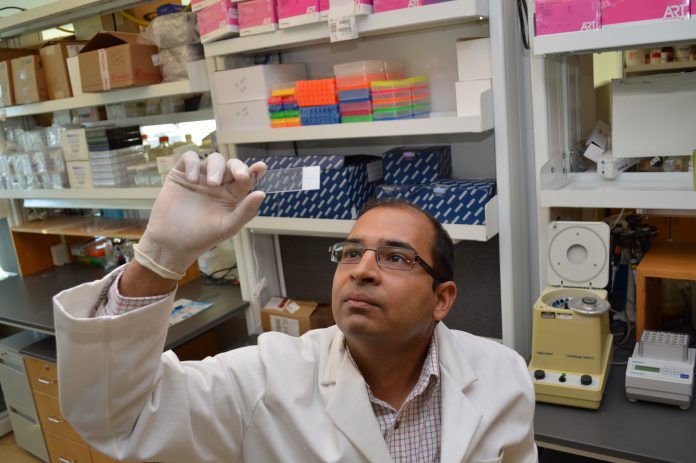The human lymphatic system is a network of vessels and lymph nodes that spans the entire body. Lymphatic vessels absorb tissue fluids and return them to the bloodstream. Defects in lymphatic vessels can cause lymphedema, a disease characterized by dramatic and painful swelling in the limbs that can lead to infection.
While there is no cure for lymphedema, Oklahoma Medical Research Foundation scientists Xin Geng Ph.D., and Sathish Srinivasan, Ph.D., have identified the molecules that control the formation of the key valves that direct the flow of lymph into the blood circulation. The findings, which were published in the journal Developmental Biology, may help researchers develop new ways to manage lymphedema.
“Using high-power imaging techniques, we were able to determine the three-dimensional structure of the lymphovenous valves in mouse embryos,” said Srinivasan. “We found that these valves are defective in four different models of lymphedema.”
There are only four lymphovenous valves in the entire human body—two on either side of the neck. Srinivsan said the valve system functions something like the intersection of two major highways.
“During peak rush time, the traffic flow is dictated by what’s happening at the junction where the highways meet,” he said. “If something occurs to block traffic at that busy intersection, it causes a traffic jam and lines of traffic build up. Similarly, malfunctions in the lymphovenous valves act like a bottleneck and can bring everything to a halt. Even if the system is functioning well everywhere else, if these valves are defective, the lymph can’t go anywhere.”
By mapping these valves in three dimensions, it allowed medical researchers the ability to look at them in detail for the first time. Srinivasan said he and his colleagues found an immediate correlation between malformed valves and disease.
This wealth of new information is crucial, said Srinivasan, because it creates an opportunity for clinical intervention in lymphedema. Currently, the only options are conservative treatments like massage and compression bandages.
“If we can repair the damage in these structures, it is quite possible that we can, at least to a certain extent, repair the damage to the lymphatic vascular function,” said Srinivasan. “This is an exciting step with many possibilities.”
Other OMRF scientists who participated in the work are Boksik Cha, Ph.D., Riaj Mahamud, Robert Silasi-Mansat, Ph.D., Lijun Xia, M.D., Ph.D., and Florea Lupu, Ph.D.
This research was supported by institutional funds of OMRF, Oklahoma Center for Adult Stem Cell Research grant No. OCASCR 4340, American Heart Association grant No. 15BGIA25710032 and National Institute of General Medical Sciences grant No. P20 GM103441.
The human lymphatic system is a network of vessels and lymph nodes that spans the entire body. Lymphatic vessels absorb tissue fluids and return them to the bloodstream. Defects in lymphatic vessels can cause lymphedema, a disease characterized by dramatic and painful swelling in the limbs that can lead to infection.
While there is no cure for lymphedema, Oklahoma Medical Research Foundation scientists Xin Geng Ph.D., and Sathish Srinivasan, Ph.D., have identified the molecules that control the formation of the key valves that direct the flow of lymph into the blood circulation. The findings, which were published in the journal Developmental Biology, may help researchers develop new ways to manage lymphedema.
“Using high-power imaging techniques, we were able to determine the three-dimensional structure of the lymphovenous valves in mouse embryos,” said Srinivasan. “We found that these valves are defective in four different models of lymphedema.”
There are only four lymphovenous valves in the entire human body—two on either side of the neck. Srinivsan said the valve system functions something like the intersection of two major highways.
“During peak rush time, the traffic flow is dictated by what’s happening at the junction where the highways meet,” he said. “If something occurs to block traffic at that busy intersection, it causes a traffic jam and lines of traffic build up. Similarly, malfunctions in the lymphovenous valves act like a bottleneck and can bring everything to a halt. Even if the system is functioning well everywhere else, if these valves are defective, the lymph can’t go anywhere.”
By mapping these valves in three dimensions, it allowed medical researchers the ability to look at them in detail for the first time. Srinivasan said he and his colleagues found an immediate correlation between malformed valves and disease.
This wealth of new information is crucial, said Srinivasan, because it creates an opportunity for clinical intervention in lymphedema. Currently, the only options are conservative treatments like massage and compression bandages.
“If we can repair the damage in these structures, it is quite possible that we can, at least to a certain extent, repair the damage to the lymphatic vascular function,” said Srinivasan. “This is an exciting step with many possibilities.”
Other OMRF scientists who participated in the work are Boksik Cha, Ph.D., Riaj Mahamud, Robert Silasi-Mansat, Ph.D., Lijun Xia, M.D., Ph.D., and Florea Lupu, Ph.D.
This research was supported by institutional funds of OMRF, Oklahoma Center for Adult Stem Cell Research grant No. OCASCR 4340, American Heart Association grant No. 15BGIA25710032 and National Institute of General Medical Sciences grant No. P20 GM103441.












